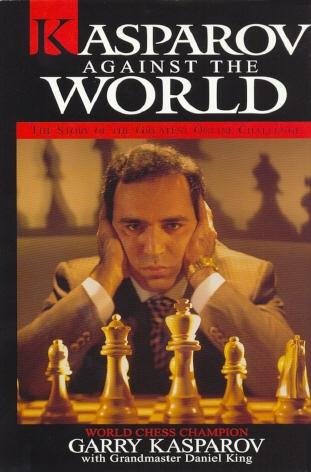
Edward Winter
An exceptional webpage by Tim Krabbé already covers chess records relating to the practical game (such as the latest castling, greatest number of checks, most promotions and earliest stalemate), and as far as possible our present article has avoided overlap. It is no longer being updated (as of 21 November 2020).
A 202-page book was devoted to a single game: Kasparov Against the World by G. Kasparov with D. King (New York, 2000), although there was also much diary material. (C.N. 2483; pages 176-177 of A Chess Omnibus.)

An earlier suggestion, by René Olthof (Rosmalen, the Netherlands), was put forward in C.N. 675 (see page 117 of Chess Explorations): Hübner’s analysis of his game against Portisch given in the tournament book of the 5th Interpolis Schaaktoernooi 1981 at Tilburg – on pages 15-44.
Oldest
David Lawson (né Charles Whipple, 1886-1980) was aged 89 when his book Paul Morphy The Pride and Sorrow of Chess (New York, 1976) was published. (C.N. 287; pages 108 and 262 of Chess Explorations.)
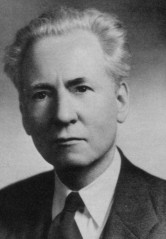
David Lawson
From Michael McDowell (Westcliff-on-sea, England):
‘The book Chess Problem Gems by Eight Eminent American Composers by Kenneth S. Howard (1882-1972) was published by Dover in 1972; or, to be more precise, the back cover says, “A Dover original, first published in 1973”, while an unnumbered inside page states, “Chess Problem Gems by Eight Eminent American Composers is a new work, first published by Dover Publications, Inc., in 1972”. The copyright reference on the same page gives 1972.’
We note that Howard’s book was first mentioned by Chess Life & Review on page 327 of the June 1973 issue:
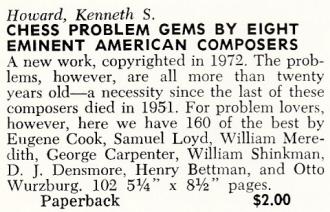
(8562)
Youngest
Murray Chandler (born on 4 April 1960) brought out A White
Pawn in Europe in 1975 (privately printed in Wainuiomata).
It gave his games at the World Junior Championship in Yugoslavia
and English tourneys from August to November 1975. (Contribution
by Robert Meadley in C.N. 662; page 108 of Chess Explorations.)
See too C.N. 3988.
John Donaldson (Berkeley, CA, USA) points out that a volume by Daniel Naroditsky is due to be published by New in Chess in 2010. Its title is Mastering Positional Chess: Practical Lessons of a Junior World Champion.
We are also grateful to Mr Donaldson for obtaining from Vladimir Naroditsky his son’s birth-date: 9 November 1995.
(6310)
The book was published in March 2010:
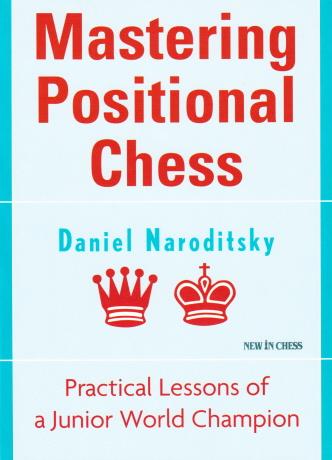
***
Who is the youngest person to have been the subject of a chess book?
Our best offer is Reshevsky, who was eight at the time of the appearance of Samuel Rzeschewski das Schachwunderkind by B. Kagan (Berlin 1920). The following year Kagan brought out Der Schachwunderknabe Samuel Rzeschewski in Amerika. They were small publications (32 pages and 14 pages respectively).
(2599)
Largest number of boards
M. Najdorf played 45 games blindfold and simultaneously at the Prestes Maia Gallery, São Paulo, Brazil on 24-25 January 1947. He scored +39 –2 =4 in approximately 23 hours. A report and all 45 game-scores were given on pages 169-179 of Miguel Najdorf El hijo de Caissa by Nicolás Capeika Calvo (Buenos Aires, 2002).
In Sontheim an der Brenz on 26-27 November 2011 Marc Lang played 46 games blindfold and simultaneously, scoring +25 –2 =19.
Shortest
The shortest book review appeared in C.N. 3480. It was wordless:
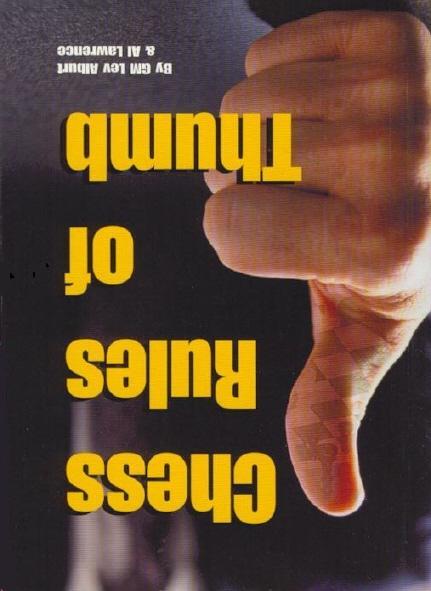
Bestselling
Bobby Fischer Teaches Chess (first published in 1966) has sold over one million copies. (C.N. 2267; page 147 of A Chess Omnibus.)

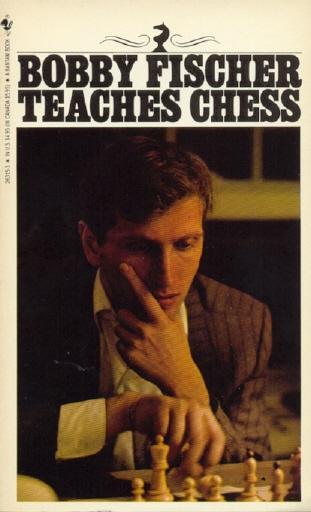
Earliest chess content
The earliest printed book with chess content was Summa Collationum by Johannes Gallensis or John of Waleys (Cologne, Ulrich Zel, circa 1470). (Contribution by Michael Macdonald-Ross in C.N. 484; page 114 of Chess Explorations. See also C.N. 4536.)
Smallest
C.N. 4244 mentioned Sakkvilágbajnokok by Károly Molnár (Budapest, 1977), a 243-page hardback on the world champions. It measures approximately 6cm x 4cm, and for purposes of comparison it appears below alongside a CD:
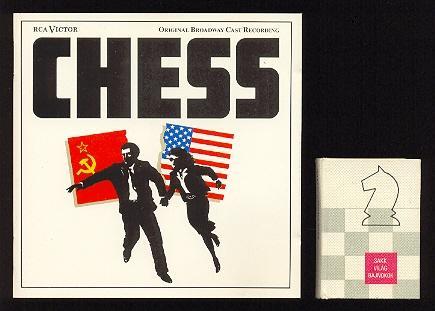
Smallest
New editions of the book Guinness World Records are no longer monitored here but, as mentioned in C.N. 11540, the Guinness company has a database which includes many chess-related exploits. One of them, dated 2020, is headed ‘Smallest handmade chess set’.
For purposes of comparison, below is C.N. 377 (written in 1983):
A report in the Tribune de Genève of 1 February 1983 says that five students at the Ecole d’ingénieur de Genève (Philippe Cantin, Jean-Marie Croisier, Robertino Noventa, David Ribaut and Marc Schmidt) have made what is thought to be the smallest chess set in the world. The peg-in board measures 8 mm by 8 mm; the size including the border frame is 12 mm x 12 mm. Each square is 1 square mm, the pawns are 1.5 mm high, while the tallest piece, the king, measures 2.5 mm. An actual game can be played with it. Four hundred hours of work went into it, and the Livre des records is now doing its research to try to establish whether this is indeed a world record.
The chess set was referred to on the front page of the Geneva newspaper, and the detailed report, by Jean-Noël Cuénod, was on page 9:
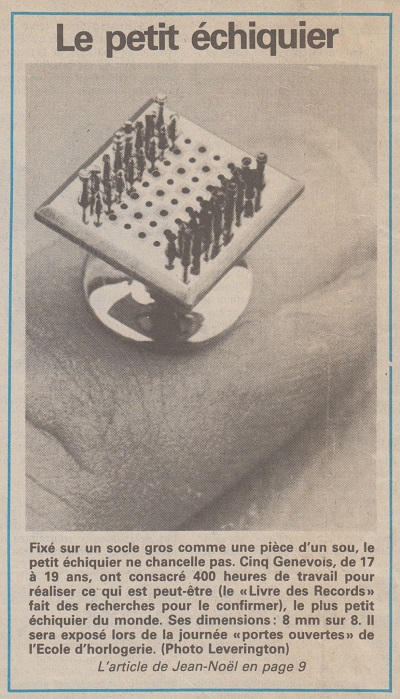
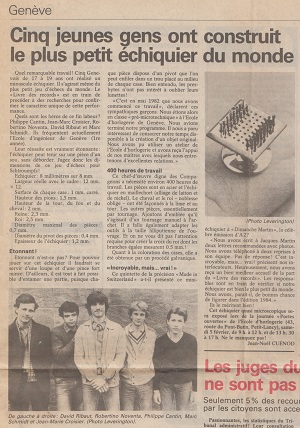
(11822)
First
The Life of Philidor by George Allen (New York and Philadelphia, 1865) has references to chess clubs in London in the 1770s. Page 70 states:
‘In 1770, a new Club, at the Salopian Coffee-house, had superseded the heroic rendezvous of Old Slaughter.’
From page 72:
‘In 1774, therefore, they formed a new Club in St James Street, under the very shadow of the Palace. The number of members was limited to a hundred ... statesmen, warriors, men of letters – all crowded forward to enter its ranks.’
Page 73 relates that the Club financed Philidor’s attendance there from February to June of each year, and page 74 notes that Philidor dedicated his 1777 edition of Analyse du jeu des échecs ‘to the very illustrious and honourable Members of the Club’.
(Acknowledgement: Robert John McCrary (Columbia, SC, USA).)
Oldest
The Schachgesellschaft Zürich was founded in 1809, as stated on, for instance, page 7 of the Zurich, 1934 tournament book. The first documentation (a balance sheet) dates from 1810. (Contribution from Richard Forster (Zurich).)
First
Egerton Smith published a chess column in the Liverpool Mercury which began on 9 July 1813.
Longest tenure

Hermann Helms
From the obituary of Hermann Helms (1870-1963) on page 32 of the February 1963 Chess Life:
‘Establishing a remarkable record for chess journalism, he began his column for the Brooklyn Daily Eagle in October 1893 and continued it decade after decade until the paper folded in 1955.’
However, in C.N. 4784 John Hilbert (Amherst, NY, USA) drew attention to the following news item on page 114 of the May 1911 American Chess Bulletin:
‘The many readers of the chess department of the Brooklyn Daily Eagle, which flourished from October 1893 to November 1907, when it was discontinued by the management, will no doubt be glad to learn of its resumption on 23 March last, under the editorship of Hermann Helms.’
C.N. 4799 reported that the obituary of George Koltanowski in the San Francisco Chronicle of 7 February 2000 stated that he ‘wrote more than 19,000 chess columns for the San Francisco Chronicle’ and that ‘his column, which appeared in the Chronicle every day without interruption for 52 years, was the longest-running daily chess column in history’.
In C.N. 4841 John Donaldson (Berkeley, CA, USA) reported that George Koltanowski’s first chess column in the San Francisco Chronicle was published on page 7L of the 9 May 1948 issue. Initially it was a weekly column, and the top part of the first one is reproduced here:
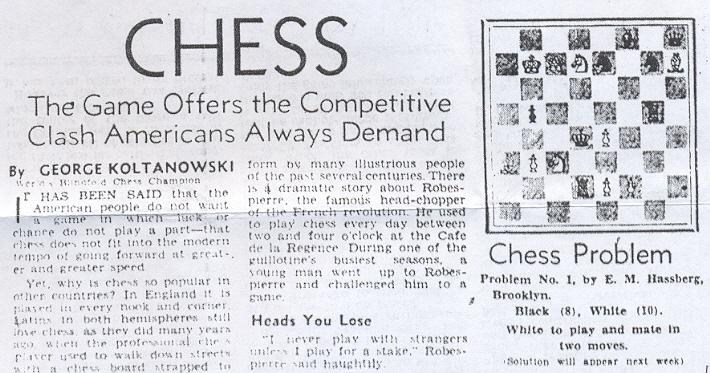
Koltanowski continued the column until his death in February 2000, i.e. for a total of almost 51 years and nine months.
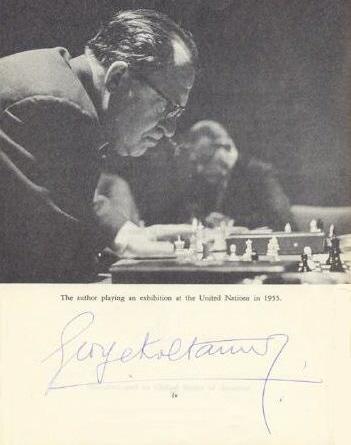
George Koltanowski (inscription in Koltanowski’s Chess Annual 1955)
Regarding Koltanowski, see also C.N. 1644 in Chess Jottings.
The item below (C.N. 6712) was written in August 2010:
Leonard Barden (London) informs us that his daily (Monday-Friday) chess column in the London Evening Standard began in early June 1956. Apart from one week in May 2009 when it appeared on-line only, the column continued in the newspaper until 30 July 2010. Since then, it has been published exclusively on-line.
Has there ever been, in any journalistic field, such a run for a daily column by a single individual?
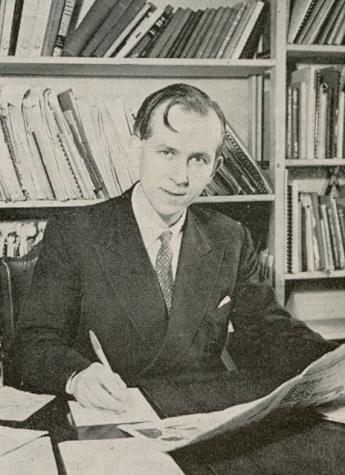
Leonard Barden (Chess Life, August 1962, page 169)
In his Evening Standard column on 30 June 2016 Barden wrote:
‘Today’s puzzle marks a record 60 years of the Evening Standard chess feature, the longest running daily column on any subject by a single individual in the history of journalism. In the 1970s a strike by printers meant that chess notation had to replace the diagrams, yet still not a day has been missed since June 1956. If you are one of the faithful readers who have followed Evening Standard chess for years or even decades, thank you for your loyal support. Now on to the 70 year mark ...’
Concerning the break in Hermann Helms’ column in the Brooklyn Daily Eagle, see too C.N. 9688.
Leonard Barden informs us:
‘The daily chess column in the Evening Standard will finally reach its end on Friday, 31 January 2020. I have given the starting-date as Monday, 4 June 1956 since although I am not totally sure of the exact date I recall that it was early June and some time after Whitsun, which was in May that year. The total is thus 63 years, 7 months and 27 days without a day missed. The final puzzle is a Carlsen win from the 2019 world blitz championship.’
(11695)
Addition on 31 January 2020: the final chess column in the Evening Standard is reproduced below, with permission:

Slowest
C.N. 3435 quoted a paragraph from page 215 of CHESS, 17 May 1957:
‘H. Jarvis, Croydon, played postal chess from 1931 (when he went on holiday to Germany) onwards, with Eberhardt Wilhelm, secretary of the international correspondence chess organization. When the war started, it was Mr Jarvis to move. Naturally the game was abruptly interrupted, and after the war ended it was two years before normal postal services were resumed. Wilhelm thereupon wrote and pointed out that it had been Mr Jarvis’ move for eight years and said that if he did not reply by return he would claim the game. Mr Jarvis had the move ready; he despatched a move at once and the games were duly concluded. So the one move took eight years. “Is this a record” asks Mr Jarvis “for the longest time ever taken to play a chess move?”’
The same C.N. item also gave a game which took about 16 years and was widely published in the mid-1870s:
Karl Brenzinger – Francis Eugene Brenzinger
Correspondence, 1859 – 18 March 1875
Two Knights’ Defence
1 e4 e5 2 Nf3 Nc6 3 Bc4 Nf6 4 Ng5 d5 5 exd5 Na5 6 Qe2 Nxc4 7 Qxc4 Bd6 8 d3 O-O 9 Nc3 h6 10 Nge4 Kh8 11 O-O Nh5 12 d4 f5 13 Nxd6 cxd6 14 dxe5 dxe5 15 Qe2 Qe8 16 Nb5 f4 17 f3 Ng3 18 hxg3 fxg3 19 f4 Bd7 20 Nd6 Qe7 21 Ne4 Qh4 22 Nxg3 Qxg3 23 Rf3 Bg4 24 Rxg3 Bxe2 25 Re3 Bc4 26 d6 Rxf4 27 Re1 Rd4 28 b3 Bb5 29 c4 Bc6 30 c5 Rg4 31 Re2 Rf8 32 Be3 Kg8 33 a4 Rb4 34 Rb2 Kf7 35 Bd2 Rg4 36 Bc3 Ke6 37 b4 Rf3

38 Bxe5 Kxe5 39 b5 Be4 40 Rd2 Rfg3 41 Raa2 Bxg2 42 d7 Bc6+ 43 Kh2 Bxd7 44 Rxd7 Rg6 45 Re2+ Kf6 46 Rde7 (This mistake was attributed to impatience after Black took seven months over his 45th move.) 46...Rg2+ 47 Rxg2 Rxg2+ 48 Kxg2 Kxe7 49 Kf3 h5 50 a5 Kd7 51 White resigns.
Sources: La Stratégie, 15 May 1875, pages 141-143, and Deutsche
Schachzeitung, July 1875, pages 218-219.
Although the magazines specified that White and Black lived in Pforzheim and New York respectively, Irving Chernev (on page 129 of his book Wonders and Curiosities of Chess) stated that the game was ‘between a Mr Brenzinger of New York and his brother in England’. In C.N. 3438 John Hilbert provided Steinitz’s notes to the game, from The Field, 24 April 1875.
C.N. 5683 reverted the subject when a correspondent, Joost van Winsen (Silvolde, the Netherlands), noted that the game below, from Turf, Field and Farm, 4 June 1875, had apparently lasted longer:
Francis Eugene Brenzinger – Karl Brenzinger
Fifth match game, correspondence, 1859 – May 1875
Vienna Gambit
1 e4 e5 2 Bc4 Nc6 3 Nc3 Nf6 4 f4 Bc5 5 Nf3 Ng4 6 Bxf7+ Kf8 7 Rf1
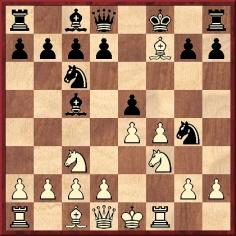
7...Nxh2 8 Qe2 Nxf1 9 Qxf1 Qf6 10 Bb3 Nd4 11 d3 Nxf3+ 12 Qxf3 Bb4 13 Bd2 Bxc3 14 bxc3 exf4 15 Bxf4 d6 16 Kd2 Ke7 17 e5 dxe5 18 Re1 Rf8 19 g3 Kd8 20 Qd5+ Qd6 21 Bg5+ Kd7 22 Qh1 h6 23 Be3 Kd8 24 Qe4 c6 25 Qa4 c5 26 Qe4 Kc7 27 Bd5 Bf5 28 Qc4 Rfd8 29 Bf3 Be6 30 Qe4 Bd5 31 Qxd5 Qxd5 32 Bxd5 Rxd5 33 c4 Rd6 34 Bxc5 Re6 35 d4 g6 36 d5 Ree8 37 Rf1 b6 38 Rf7+ Kd8
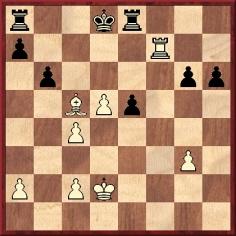
39 Rxa7 Rxa7 40 Bxb6+ Ke7 41 Bxa7 Rc8 42 c5 Ra8 43 Bb6 Rxa2 44 Kd3 Ra3+ 45 Ke4 Rxg3 46 Kxe5 Rg5+ 47 Kd4 Rg1 48 c4 Rb1 49 Bc7 h5 50 c6 h4 51 Bf4 Rd1+ 52 Kc5 h3 53 d6+ Kd8 54 d7 Rg1 55 Bd2 Rd1 Drawn.
Earliest game
C.N. 4835 included a contribution from José Antonio Garzón (Valencia, Spain) about the earliest game played under modern rules:
‘The game appears in the poem “Scachs d’amor”, Valencia, circa 1475. It is the work of three famous Valencian poets, Bernat Fenollar, Narcis Vinyoles and Francí Castellví. Castellví plays the red (white) pieces and Vinyoles the green (black) ones, while Fenollar is the referee, describing in his interventions the birth of modern chess and providing a first set of rules. The opening is a Centre Counter-Gambit (1 e4 d5 2 exd5 Qxd5), so as to “show” the new piece from the very beginning. The poets describe the movement of the new piece, claiming to have invented it (stanzas 1 and 54), and thus confirming the Spanish origin of modern chess.
The poem and game were discussed on pages 257-300 of La reina Isabel la Católica: su reflejo en la dama poderosa de Valencia, cuna del ajedrez moderno y origen del juego de damas (Valencia, 2004), which I co-authored with Govert Westerveld, and on pages 331-352 of my book El Regreso de Francesch Vicent. La Historia del nacimiento y la expansión del ajedrez moderno (Valencia, 2005).’
Concerning games played before the introduction of the modern rules, see the article ‘The oldest recorded games of chess’ by H.J.R. Murray on pages 441-449 of the November 1903 BCM.
Fewest games lost by a world champion
José Raúl Capablanca lost only 34 games in his adult career (1909-1939). He was unbeaten from 10 February 1916 to 21 March 1924. (C.N. 164 and 1988 Guinness Book of World Records, page 565.)
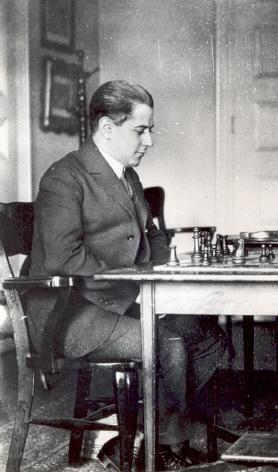
José Raúl Capablanca
Youngest
‘The youngest individual to qualify as an International Grand Master is Sergey Karjakin (Ukraine, born 12 January 1990), who did so on 12 August 2002 aged 12 years 212 days.’ (Guinness World Records 2007, page 99.)
First
Le Palamède, edited by L.C.M. de Labourdonnais and J. Méry, began publication in 1836.
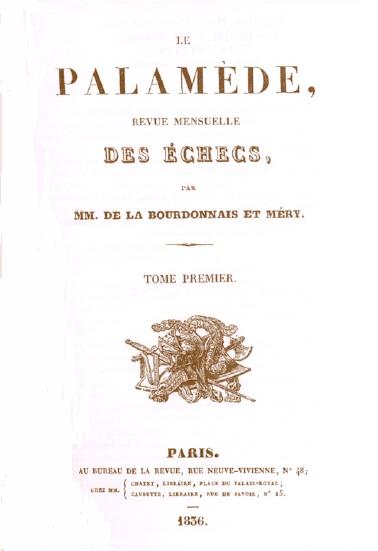
Youngest editor
As reported in C.N. 8231, in a letter to us dated 8 October 1983 Albrecht Buschke (New York) wrote:
‘Max Lange (1832-1899) was only 16 or 17 when he edited the Magdeburger Schachzeitung in 1849.’
The Magdeburger Schachzeitung can be read on-line.
From page vii of ‘Mr Chess’ The Ortvin Sarapu Story by Ortvin Sarapu (Wainuiomata, 1993):
‘The record shows that I have won outright or shared the title of New Zealand champion on 20 occasions. Not only is this the most titles for New Zealand, but also for the world. No other player has ever won so many national championships. Eight times I was “relegated” to runner-up and once to fourth.’
(2102)
Youngest player of a published game
José Raúl Capablanca, receiving queen odds, defeated Ramón Iglesias in Havana on 17 September 1893 when he was four years and ten months old. (C.N. 2146; page 234 of Kings, Commoners and Knaves.)
Youngest composer of a published problem
Page 132 of the May-June 1917 American Chess Bulletin published a composition by Elliot Franklin Eichholtz, who was stated to be five years old. (C.N. 2184; page 234 of Kings, Commoners and Knaves.)
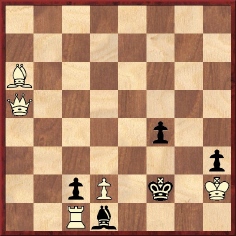
Mate in two moves
Largest number of boards
On the subject of records over the past decade for the largest number of games played in a simultaneous display, the most detailed series of reports has appeared at ChessBase.com. Below are the relevant links for the records claimed:
(9349)
Claims regarding alleged simultaneous displays by Dimitrije Bjelica (Sarajevo, 1982 and Subotica, 1997) are discussed in C.N. 11591. Concerning the exhibition by Bojan Kurajica (Sarajevo, 1991), see C.N. 11592. For a 1973 claim by Jude Acers see Large Simultaneous Displays.
Fewest moves played
In the 2003 Capablanca Memorial tournament, Premier I group, Péter Székely of Hungary played a total of 130 moves (his opponents played 133) in the 13 rounds. He scored +0 –0 =13, with an average of ten moves per round. His smallest number was six, and his longest game lasted 13 moves. He won fourth prize since he had the highest Sonneborn-Berger score of the four players on 50%. (Contribution by Calle Erlandsson in C.N. 2937; page 81 of Chess Facts and Fables. See too Chess Jottings.)
Most wins
See C.N. 9791 (concerning Neumann, Chigorin and Marshall).
Oldest
William (né Wilhelm) Steinitz (born in May 1836) lost his world chess championship title on 26 May 1894, when aged a little over 58 years.
Youngest
When Garry Kasparov became world champion on 9 November 1985 by defeating Anatoly Karpov he was aged 22 years 210 days.
Between 1993 and 2006 there was no consensus on the identity of the world champion. On 22 January 2002 Ruslan Ponomariov, aged 18 years 103 days, defeated Vassily Ivanchuk in a match for the FIDE world championship.
Latest update: 21 November 2020.
To the Chess Notes main page.
To the Archives for other feature articles.
Copyright: Edward Winter. All rights reserved.